MENU
MENU
Tea production area: Shizuoka City, Fujieda City, Kawanehon Town, Fujinomiya City, Fuji City, Numazu City, Gotemba City, Susono City, Mishima City, Izunokuni City, Ito City and Shimoda City
Brand name of tea: Shizuoka tea, Ryougouchi tea, Honyama tea, Abe tea, Tamagawa tea, Ashikubo tea, Miwa tea, Utogi tea, Asahina gyokuro, Kawane tea, Fujinomiya tea, Fuji tea, Numazu tea, Susono tea, etc.
Types of tea: Sencha (medium steamed green tea), fukamushicha (deep steamed green tea), kukicha (stem tea), matcha, tencha, hojicha (roasted green tea), genmaicha (popped rice green tea), gyokuro (high quality shaded tea), kabusecha (shaded green tea), black tea, bancha, powdered tea, oolong eta, flavored tea, etc.
Suitable climate for cultivating tea
Shizuoka Prefecture has a warm climate with many rivers, and fog is often generated. Many parts of Shizuoka Prefecture are suitable for tea cultivation.
History of Shizuoka tea
Tradition says that Shizuoka’s tea began when Shoichi Kokushi (聖一国師), a Buddhist monk, brought back tea seeds to Japan from Sung (China) and planted them in Ashikubo, Shizuoka City in 1244.
The central part of Shizuoka Prefecture
There are many tea fields in basins of the Warashina River, the Abe River and the Okitsu River and Nihondaira. It is said that Ieyasu Tokugawa, the first shogun, loved Honyama tea which was produced in the Warashina and the Abe River basins, a mountainous area.
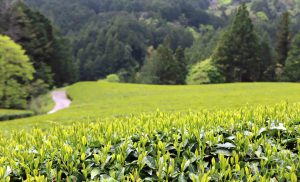
Tea fields of Jisyabatakeen located in the Okitsu river basin of Shizuoka City (April 2021)
The eastern part of Shizuoka Prefecture
Tea is cultivated and produced at the southwestern foot of Mt. Fuji, the southern foot of Mt. Ashitaka and the Izu Peninsula. Sencha, black tea, tamaryoku tea and various tea are produced there.
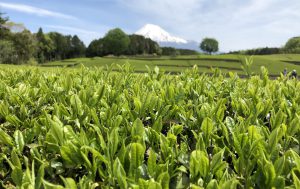
Obuchisasaba, Fuji City (May 2019)
Motokichi Tada, father of Japanese black tea
Motokichi Tada (1829-1896), a former shogunate retainer moved to the Maruko District in Shizuoka City after the Meiji Restoration and began cultivating tea.
Under the order of the Meiji government which hastened the production of black tea in Japan, Motokichi was dispatched to Qing (China) in 1875 and to India and Sri Lanka in 1876 to investigate the tea market, black tea production method and technology. After returning to Japan, Motokichi visited many places in Japan to spread this method.
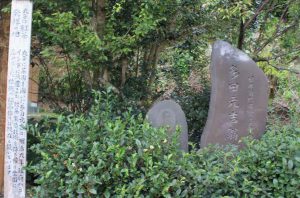
The stone monuments for Motokichi TADA (September 2017)
Hikosaburo SUGIYAMA, the creator of the excellent variety “Yabukita”
Yabukita is an excellent variety of tea plant that is easy to cultivate anywhere in Japan and is resistant to diseases. Currently, about 70% of all tea tea fields in Japan are cultivated with Yabukita.
Hikosaburo SUGIYAMA (1857-1941), who was born in Shizuoka City, cultivated tea plants. In the course of tea cultivation, he found the importance of breed improvement of tea plants. He visited many tea fields to search for good tea plants and created the Yabukita variety.
Fujieda Asahina gyokuro
Fujieda City is one of three major gyokuro production places in Japan. The other two are Uji, Kyoto Prefecture and Yame, Fukuoka Prefecture.
Gyokuro is high quality steamed green tea. Poles are erected in tea fields, which are then covered with rice straw woven mats or man-made black mats, in order to block sunlight for 2 to 3 weeks before new buds are picked by hand. Gyokuro is produced using only new buds. When sunlight is blocked, catechins (bitterness components) are suppressed and amino acids (umami components) increase. Now there are only a few gyokuro tea farmers who use rice straw woven mats. Covering with straw woven mats is the traditional way, but the weight is more in comparison to man-made black mats. In Fujieda City, only a few tea farmers cultivate rice and weave the mats with straw after threshing. The mat is called komo in Shizuoka Prefecture. The mat can be used for several years and is put in the fields. Finally, it becomes compost. Traditional gyokuro cultivation is circular agriculture.
Gyokuronosato is located in Fujieda City. You can have lunch and sweets using gyokuro at the restaurant and drink gyokuro in the traditional Japanese tearoom there.
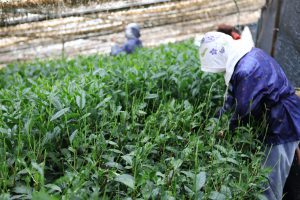
Plucking new tea leaves in a gyokuro tea garden “Miyazakien” in Fujieda City (May 2021)
Fujieda large tea plant
There is a large tea plant which is estimated at 300 years of age in Fujieda City. The height is about 4 meters, and the circumference is about 33 meters. Tea leaves are picked in May every year.
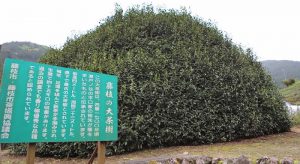
Fujieda large tea plant (April 2019)
Kawane tea and Kawane Jikan (Kawane Time)
Kawanehon Town is located in the mountainous area at the reaches of the Oigawa River which source is the Minami Alps. Kawane tea is very famous as a high grade sencha (steamed green tea) with a strong umami taste.
An event “Kawane Jikan” is held in November every year. In the event, Chakabuki (茶歌舞伎 tea guess game), tasting Kawane tea and making hand rolling tea, etc.. are conducted.
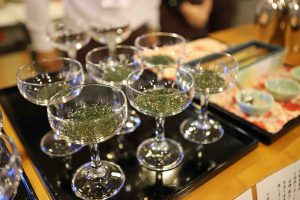
Kawane time (November 2019)
Micinoeki Faure Nakakawane CHAMEIKAN
There is a traditional Japanese tearoom and garden in Michinoeki Faure Chameikan, Kawanehon Town. In the tearoom, you can drink Kawate tea with Japanese confectionaries.
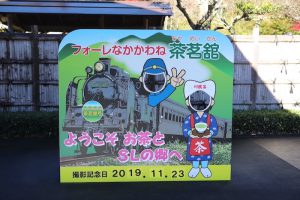
CHAMEIKAN (November 2019)
Tea tourism
Tea tourism has been widely promoted in Shizuoka Prefecture. There are many tea shops, tea rooms, stone monuments, facilities related to tea, as well as many events, tours and activities related to tea.

Parade of Ochatsubodochu when a tea jar with tea for the Shogune was delivered to
Tokugawa Shogunate in Shizuoka City (November 2019)
Obuchi ocha matsuri (Obuchi tea festival)
Mt. Fuji and tea fields at Oubuchisasaba in Fuji City can be seen without any artificial objects such as frost prevention fans. A tea festival is held in May every year.
During the festival, a photo shoot of “Mt. Fuji and tea picking girls” is held, and many amateur cameramen take photos. Local junior and high school female students wear traditional costumes for picking tea leaves.
Tea and tea leaf tempura (deep fried tea leaves) are also served to visitors, and tea is sold at the event.
The festival was cancelled in 2021 and 2022 due to concerns over the spread of the coronavirus (COVID-19).
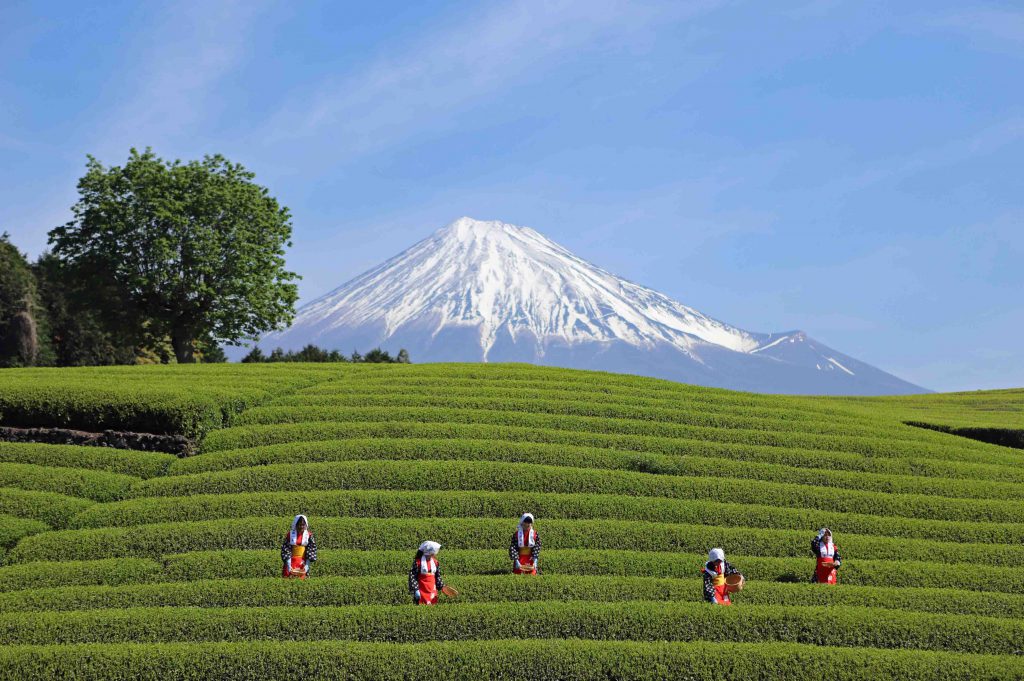
Obuchi ocha matsuri (Obuchi tea festival) (May 2019)
A travel agency “Soft Kenkyushitsu” has pioneered tea tourism and conducted various tea tours such as a Shizuoka tea market tour, tea factory tour, tea picking tour, etc. Now they are conducting a tour via the Internet as well.
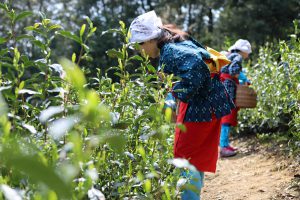
Tea picking tour conducted by Soft Kenkyusho (April 2019)
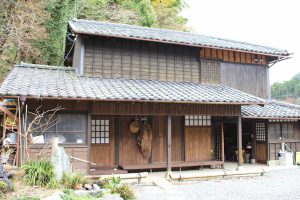
Tea farm inn “Nukumorien”, Shizuoka City (March 2018)
Tea terrace Chanoma (茶の間)
Some tea farmers have built terraces in their tea gardens where visitors enjoy their tea and beautiful tea fields on the terrace. A company has introduced seven terraces in Shizuoka Prefecture. The company calls these terraces Chanoma (茶の間). Chanoma means “private family living room for drinking tea”. One chanoma is “Koganemidori chaen” (golden green tea garden) in Shizuoka City. The company provides a wedding photo service on the terrace.
Chanoma https://changetea.jp
Related article on the site:「お茶の種類 黄金みどり」
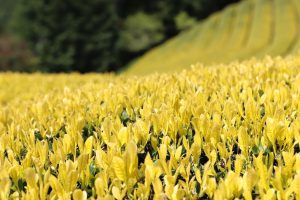
“Kogane midori chaen” (golden green tea garden), Shizuoka City (April 2021)
Ranji label
Ranji label is a drawing pasted on a chabako, which is a wooden box for exporting Japanese tea. Chabako was used from the late 19th century to the early 21st century. The design of Ranji is excellent. Ranji labels are exhibited at Verkehr museum in Shizuoka City.
Related article on the site:「船と港の博物館 フェルケール博物館」

Ranji labels at Verkehr museum in Shizuoka City (March 2018)
Tea dyeing
Ochazome Washizu in Shizuoka City dyes clothes with tea dust and makes various products, such as scarves, t-shirts, bags, masks, etc.
The tea dust is generated on the machines and the floor during processing tea and cannot be used as a tea product.
CHAMART produced kimono and women’s suit using the cloth dyed with tea dust, by Ochazome Washizu
CHAMART requested an antibacterial test (Staphylococcus aureus) of the cloth which was dyed with the tea dust by Washizu by an inspection company in 2018. The result showed suppression of bacterial growth and a deodorizing effect on the cloth. *1
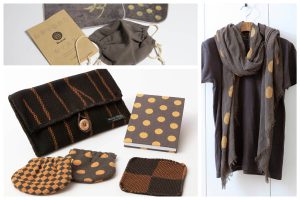
Ochazome Washizu’s products
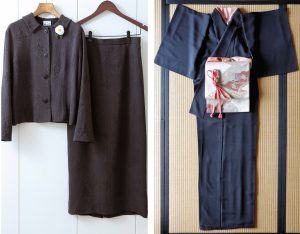
Kimono and woman’s suit using cloths dyed with tea dust
*Note 1: Antibacterial test at Nissenken Quality Evaluation Center (Test method: JIS L1902: 2015 Bacterial solution absorption method (quantitative test), Measurement method: Plaid plate culture method, Test prohibited: Yellow staphylococcus, test sample Treatment: Performed autoclave sterilization). The results of this test show the antibacterial properties of the cloth tested, not all tea dyes.
Tea related facilities:
Shimizu Port Terminal Museumフェルケール博物館
https://www.suzuyo.co.jp/suzuyo/verkehr/
Monument of the birth of Shizuoka tea 静岡茶発祥の碑
https://www.ochanomachi-shizuokashi.jp/recommend/5000/
Monument of Shoichi kokushi 聖一国師生誕碑 https://www.ochanomachi-shizuokashi.jp/recommend/5001/
Monument of Tada Motokichi 多田元吉翁碑 https://www.ochanomachi-shizuokashi.jp/recommend/5002/
Jisyabatakeen 寺社畑園 https://www.jisyabatake.jp
Tea farm inn Nukumurien お茶農家民宿ぬくもり園ゆるり
https://nukumorien.i-ra.jp
Gyokuronosato 玉露の里 http://shizutetsu-retailing.com/gyokuronosato/
Fujieda big tea plant 藤枝の大茶樹 https://www.city.fujieda.shizuoka.jp/sangyo/cha/1461668631652.html
Michinoeki Chameikan 道の駅フォーレなかかわね茶茗舘
https://chameikan.jp
Soft laboそふと研究室 https://soft-labo.net
Chanoma 茶の間 https://changetea.jp
Obuchi sasaba, Fuji City
富士市 大淵笹場(富士山と茶畑の絶景スポット)について
https://www.city.fuji.shizuoka.jp/machi/c0504/rn2ola000000dvpa.html
お茶染め Washizu https://www.ochazome-shizuoka-japan.com
Tea mascot Yuru-Chara:
Chappi (Shizuoka Prefecture)
Ochappi (Kawanehon Town)
Chaamin (JA Fujinomiya)
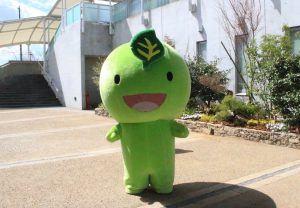
Chappi at Tea Museum, Shizuoka
Ceramic and pottery art:
Reference:
松下智 (平成3年) 日本名茶紀行 (初版) 雄山閣出版
社団法人農山漁村文化協会編集(2008年) 茶大百科 I歴史・文化/品質・機能性/品種/製茶 (第1刷) 社団法人農山漁村文化協会
公益社団法人静岡県茶業会議所 (2019年) 新版茶の品種 公益社団法人静岡県茶業会議所
高野實、谷本陽蔵、富田勲、中川致之、岩浅潔、寺元益英、山田新市 執筆 (社)日本茶業中央会監修 (2005) 緑茶の事典 改定3版 柴田書店
藤枝市 https://www.city.fujieda.shizuoka.jp/index.html
藤枝の大茶樹
https://www.city.fujieda.shizuoka.jp/soshiki/sangyoshinko/ochanomachi/gyomu/1445921287740.html
*When visiting the shops and facilities introduced in this article, please check the business hours on their website, etc. before visiting.
*The information provided on this site may be updated. If you find any information in this article that is incorrect, new, or incomplete, please contact CHAMART.
*The site does not describe all “Teas of Japan” or all “Teas of the World”. Additionally, each article expresses the writer’s personal experience and feelings.
#shizuokatea #shizuoka